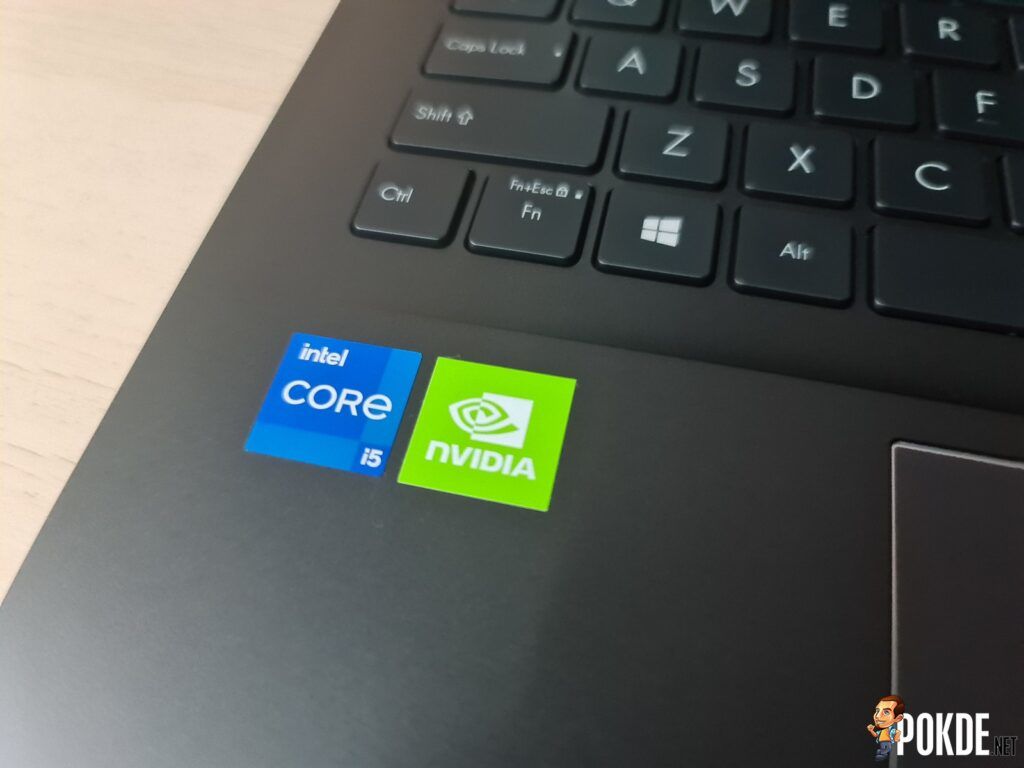ASUS VivoBook 15 K513 Review – Value-Focused Ultraportable
-
Appearance - 7.5/10
7.5/10
-
Efficiency - 6.5/10
6.5/10
-
Features - 7/10
7/10
-
Materials - 7/10
7/10
-
Performance - 7.5/10
7.5/10
-
Portability - 8.5/10
8.5/10
-
User Experience - 7/10
7/10
-
Value - 7/10
7/10
Summary
The ASUS VivoBook 15 K513 is a good ultraportable laptop for those looking reliable performance and lightweight body within a reasonable price.
Overall
7.3/10Pros
+ 11th Gen Intel Core + MX350 combo
+ 512GB NVMe SSD
+ Speakers can get rather loud
+ Wi-Fi 6 support
+ Light and easy to carry around
+ Fingerprint scanner works fast and reliably
+ Reasonable price
Cons
– No RJ45 LAN port
– Should have gone for full-sized SD card reader
– USB 2.0 in 2020 isn’t a good thing
– Battery life could be better
– Single stick RAM holds back laptop’s potential
– Lid is a bit of a fingerprint magnet
Unboxing the ASUS VivoBook 15 K513
Let’s kick off the ASUS VivoBook 15 K513 review with the unboxing. Inside the laptop box, you are expected to find the following items:
- Quick start guide
- User guide
- MyASUS leaflet
- VivoBook stickers
- HDD Kit
- 65W power adapter
- Power cable
- ASUS backpack
- The ASUS VivoBook 15 K513 laptop itself
Appearance
For our review unit, we got the Indie Black colour variant of the ASUS VivoBook 15 K513 laptop. Unlike the Cobalt Blue on VivoBook 14 that we reviewed prior, this one looks rather bland. You do have other colour options, which are Transparent Silver and Hearty Gold.
Looking at the lid, you can see the ASUS VivoBook wording towards the right. It feels rather plasticky and is a bit of a fingerprint magnet but it isn’t as bad given the colour scheme. According to ASUS, it has a mixture of aluminum alloy and plastic for a lightweight yet durable design. It does look simple with a clean, elegant finish.
Open up the lid, which requires two hands, and you get a clear view of its 15.6-inch Full HD NanoEdge display, a chiclet keyboard complete with Numpad and white backlighting, a trackpad with a fingerprint sensor, and product stickers. It’s not a bezel-less display, with the sides being thinner than the top and bottom, but it’s definitely practical as the webcam sits on the top bezel. The top and bottom bezels are still rather thin.
You can also see the ASUS VivoBook wording on the bottom bezel. It’s worth pointing out that the arrow keys are rather small, and the Enter key has a yellowish-green outline as if it’s being highlighted, just like in the other VivoBook laptops. The power button is located right above the Num Lock key.
On the left side, you will only see two USB Type-A ports and an LED indicator. As for the right side, you can find a MicroSD card reader, a 3.5mm combo audio jack, a USB Type-C port, another USB-Type A port, an HDMI port, and the proprietary charging port . There’s nothing on the rear except for a clear view of the hinge.
Moving to the bottom, you have four rounded feet, product stickers, two speaker grilles, and some air vents. It’s worth noting that the two feet at the top are more spherical compared to the two feet on the bottom, which is more flat. This is to aid the laptop by giving it a bit of a lift for better airflow. There are about 10 screws exposed here, and doesn’t seem to have any hidden screws.
Overall, the ASUS VivoBook 15 K513 seems to reuse the same design from recent VivoBook laptops. The Indie Black colour looks rather dull so you might want to opt for the other options instead. However, this is subjective. While the build quality is a little bit cheap, it does seem to be a little better than the VivoBook 14 A413 that we reviewed earlier, but not by much.
Specifications
| CPU | Intel Core i5-1135G7 @ 2.4 GHz (up to 4.2 GHz Boost), 4C/8T, 8M cache, 28W TDP, 10nm SuperFin |
| RAM | 8GB 3200MHz DDR4, single channel |
| GPU | Intel Iris Xe Graphics NVIDIA GeForce MX350 2GB GDDR5 |
| Storage | 512GB M.2 NVMe PCIe 3.0 SSD (Intel 660p) |
| Software | Microsoft Windows 10 Home Microsoft Office Home and Student 2019 MyASUS McAfee Personal Security ASUS Tru2Life ASUS Splendid Link to MyASUS |
| Connectivity | Wireless Intel WiFi 6 (Gig+) 802.11ax (2.4GHz and 5GHz) Bluetooth 5.0 Wired 1 x USB 3.2 Gen1 Type-A 1 x USB 3.2 Gen1 Type-C (DT Only) 2 x USB 2.0 1 x HDMI 1 x MicroSD card reader |
| Input | Backlit chiclet keyboard Touchpad with built-in fingerprint sensor |
| Display | 15.6″ Full HD (1920 x 1080) 16:9 IPS with wide 178°, Anti-glare NanoEdge (5.7mm bezel) Display, 84% screen-to-body ratio, 45% NTSC TÜV Rheinland Eye Care certification |
| Audio | 1 x 3.5mm Combo audio jack Harman Kardon-certified audio Built-in speaker Array microphone with Cortana voice recognition |
| Power | 42 Whr 3-cell li-ion battery 65W power adapter |
| Colours | Indie Black / Transparent Silver / Hearty Gold |
| Dimensions | 359 x 235 x 17.9 mm |
| Weight | 1.7 kg |
Performance
Starting off with CrystalDiskMark, you can see that it’s pretty decent speeds as it’s noticeably faster than your typical SATA III SSD. Given the 512GB capacity, I honestly don’t think anyone would have any complaints with this, especially given the price point, as you can still expect fast loading speeds / bootup times. In case you’re wondering, it’s the Intel 660p.
In Cinebench R15, the Intel Core i5-1135G7 performed surprisingly strong in single core, but is lagging behind in terms of multi core. This is especially apparent when you compare it to other CPUs, like the Intel Core i7-9750H and i9-10980HK.
Its single core prowess is more apparent in Cinebench R20, where it can match up with stronger CPUs like the Intel Core i9-10980HK, i7-10875H, and AMD Ryzen 9 4900HS. The multi core score isn’t much to behold but given that the ASUS VivoBook 15 K513 is geared towards productivity, it’s perfectly fine.
In Unigine SuperPosition’s 4K Optimized benchmark, we didn’t expect it to do well. While it does have a discrete GPU, it’s only a GeForce MX350 so it would be tough to run anything in 4K with that. It would need a stronger GPU as this benchmark is graphically intensive. This is evident as the highest score in the graph above, a laptop that uses a RX5500M which is far stronger than any MX-based GPU.
A similar pattern can be seen in 3DMark’s Time Spy benchmark. You can see that laptops running similar GPU will have a similar score and the lowest three laptops do not have a discrete GPU. The addition of at least a GTX 1650 would make for a whole world’s difference.
In PCMark, the ASUS VivoBook 15 K513 performs decently overall. While it does have an MX350 dGPU, the overall specifications isn’t strong enough for digital content creation. One thing’s for sure, an upgrade in RAM would definitely see a huge boost in overall performance as this only has a single stick 8GB DDR4 RAM.
As it does have an MX350 dGPU, it would be interesting to see how the ASUS VivoBook 15 K513 performs in light gaming. In DotA 2, it had an average 54FPS while in CS:GO, it’s an average of 78FPS. Yes, in CS:GO, you can actually enjoy buttery-smooth gaming without issues but in DotA 2, you may need to tweak the settings a little bit. The frames start to drop when there’s a huge team fight. An upgrade in RAM might be able to solve this but if it doesn’t just dial down the graphics settings just a little bit.
The battery life is one area that we have high expectations and the ASUS VivoBook 15 K513 laptop, and it performed decently. It managed to last 372 minutes (6 hours and 12 minutes) in PCMark’s Modern Office endurance test. I personally expected better from a laptop like this but it should be okay for a lot of people out there, especially given the price point.
If you’re looking for options and want a similar laptop, check out our review of the ASUS VivoBook S15 S533F by clicking right here.
User Experience
The ASUS VivoBook 15 K513 is an ultraportable productivity laptop, with the moniker of “world’s smallest 15-inch colourful ultraportable”. It’s designed for those looking at lightweight laptops within reasonable prices. It’s powered by the Intel Core i5-1135G7 CPU, which has Intel Iris Xe iGPU, with NVIDIA GeForce MX350 dGPU.
As for memory, it has a single stick 8GB DDR4 RAM clocking in at 3200MHz and a 512GB Intel 660p NVMe SSD. 8GB RAM is still an okay amount but the configuration will hold the laptop’s true potential back. The CPU and GPU is actually pretty great for a productivity machine so if you want the best possible experience, add another 8GB stick of RAM to the fray for that dual-channel goodness.
It uses a 15.6-inch Full HD NanoEdge display with 60Hz refresh rate. The viewing angles and colours are decent. If you do a lot of creative work that require colour accuracy, this is not the one for you, especially since it’s a little dim. It’s worth noting that you can open up the lid up to about 145°. I just wished it had touchscreen support for better productivity potential.
The ASUS VivoBook 15 K513 laptop has a decent array of ports. You get 3 USB-A ports, a USB-C port, an HDMI port, a combo audio jack, and a MicroSD card reader. I feel like they should have went for a full-sized SD card reader instead. The lack of an RJ45 LAN port might steer some folks away but you can always get a USB-C hub if you really need it. That way, you get access to more ports but it does mean you will have to spend a bit more.
As for the keyboard, I personally like it. It’s well-built, has short travel distance, you get a Numpad, and a it’s little bit soft but generally comfortable to use. You may need a bit of time to get used to the small arrow keys but it shouldn’t be a huge problem for most people.
The touchpad itself works fine but what I do like is the embedded fingerprint scanner. This way, you can keep the laptop secure while also letting you login conveniently. So far from my own experience, it works fast and reliably, successfully logging me in within 9 out of 10 tries.
On the software side of things, you have MyASUS, which you can consider as a command centre of sorts. Here, you can check driver updates, change fan settings, pick your preferred charging mode, system diagnosis, and more.
You can even adjust your display settings such as colour mode and blue light intensity here via ASUS Splendid. The Wi-Fi SmartConnect feature here will automatically connect to router with the best signal in the area when enabled. It’s a very useful software suite that you should take the time to familiarize with.
It’s also worth noting the Link to MyASUS feature, which wirelessly connects the laptop to your smartphone. This is very convenient to have as you can easily transfer files, mirror the screen, take phone calls and more using the laptop instead. It’s easy to setup and use, and I’m sure many people will benefit from this greatly for work.
As for the speakers themselves, it’s surprisingly good. It can produce pretty good sound directed towards you for a more wholesome experience. Audio is generally geared towards clarity with a clear lack of bass. Unlike the VivoBook 14 I reviewed recently, the volume is adequately loud.
ASUS VivoBook 15 K513 Verdict
The ASUS VivoBook 15 K513 is a good ultraportable laptop for those looking reliable performance and lightweight body within a reasonable price. You get a 11th Gen Intel Core CPU with MX350 discrete GPU, 512GB NVMe SSD, and Wi-Fi 6 support.
However, the single stick 8GB RAM is holding back the laptop’s true potential, the lack of an RJ45 LAN port may be a turn off for some, still has USB 2.0 ports, battery life could be better, and could have gone for a full-sized SD card reader instead. With a retail price of RM3,299, I would recommend upgrading the RAM immediately if you plan on buying this.
With that, I award the ASUS VivoBook 15 K513 laptop with our Bronze Pokdeward.

Big thanks to ASUS Malaysia for providing us this laptop for the purposes of this review.















































